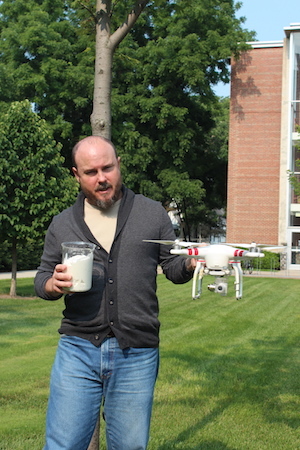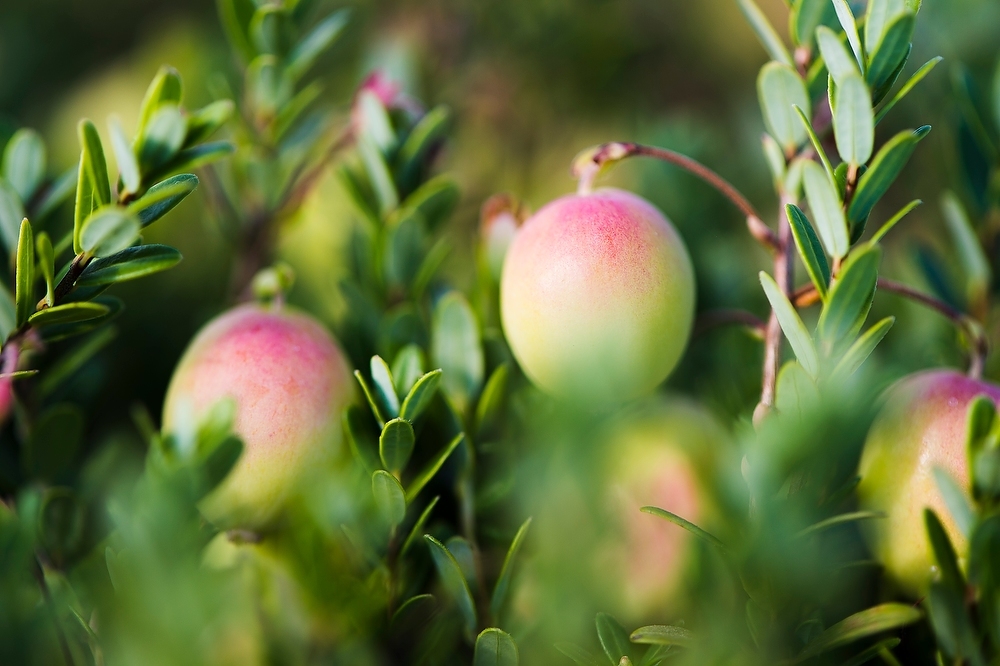CALS researchers deploy insect ‘birth control’ to protect cranberries
It’s no fun being a male moth in one of Shawn Steffan’s cranberry research plots in central Wisconsin. When the time comes to mate, it’s tough to find a partner.
Here’s why: Using an approach known as pheromone-based mating disruption, Steffan and his team dot their test fields with hundreds of dollops of pheromone-infused wax — known as SPLAT for short — that give off the scent of female moths ready to mate.
The males can’t tell the difference between the pheromone plume emanating from the SPLAT versus the real thing — and many die before they are able to home in on a real partner.
“We throw a wrench into their communication system with lots of false plumes. In essence, it’s moth birth control,” explains Steffan, a UW–Madison College of Agricultural and Life Sciences professor of entomology and a USDA entomologist.

Shawn Steffan holding a jar of pheromone-infused wax known as SPLAT, and an unmanned aerial vehicle. Steffan is working to develop a much larger UAV system to deliver SPLAT to cranberry fields. Photo: Joan Fischer
Wisconsin is the nation’s leading producer of cranberries, growing more fruit than all other states combined. Insect pests are a perennial problem, and while growers have insecticide sprays that largely do the job, Steffan notes, there’s room for improvement — especially in the interest of saving pollinators, including honeybees.
“One of the typical spray-timings for the cranberry fruitworm is when the adult moths are flying, which is right during bloom when the honey bees are out,” explains Steffan. “That’s one of the huge drivers behind pheromone-based mating disruption — to avoid spraying when pollinators are active.”
In addition to such environmental benefits, this approach could also have a major impact on growers’ bottom lines. By doing fewer pesticide applications, the state’s cranberries should have an easier time entering European and Asian markets, which have stricter rules about pesticide residue levels.
“Wisconsin fruit has sometimes failed to meet those standards,” says Steffan, “but mating disruption is poised to change that.”
Growers of all stripes are eager to get their hands on this new option, including organic growers, who need more pest control options. “This will give them a powerful new tool,” Steffan says.
To speed things along, Steffan and his team are hard at work trying to mechanize the application of SPLAT. They are particularly excited about the potential of unmanned aerial vehicles (UAVs, better known as drones) and are working with Brian Luck, a CALS/UW-Extension professor of biological systems engineering, to build the perfect UAV for the job.
Steffan’s team is also exploring reformulating the SPLAT recipe. It currently works against two of the state’s top three cranberry pests: the cranberry fruitworm and the blackheaded fireworm. But they want to go for the trifecta by adding the pheromone for the sparganathis fruitworm.
“I think this would be the first-ever three-species mating disruption blend,” says Steffan. “That’s what I dream about.”
Subscribe to Wisconsin Ideas
Want more stories of the Wisconsin Idea in action? Sign-up for our monthly e-newsletter highlighting how Badgers are taking their education and research beyond the boundaries of the classroom to improve lives.


